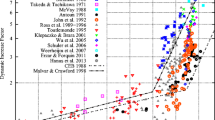Abstract
The RILEM proposal for measuring the fracture energy (GF) of mortar and concrete by means of three-point bend tests on notched beams [1] aroused a vivid discussion on the size dependence of GF. The authors of this note, in 1992, summarized in three papers [2–4] their research on the RILEM proposal, placing special emphasis on several sources of energy dissipation during testing. In particular, it was shown that the dissipated energy at the very end of the test cannot be neglected for small specimens when tests are stopped at a reasonably small rotation.
The interest raised by these papers and the publication of comments with remarkable misunderstanding, as in a recent book by Cotterell and Mai [5], call for a short note explaining in more detail some aspects of the procedure suggested by the authors to compute the nonmeasured energy from the tail in a RILEM test.
Résumé
La méthode proposée par la RILEM pour mesurer l'énergie de rupture (GF) du béton et du mortier au moyen d'essais de flexion trois points sur des poutres entaillées [1] a donné lieu à une discussion vive sur l'incidence de la taille sur GF. En 1992, les auteurs avaient résumé au cours de trois articles [2–4] leurs recherches sur cette méthode RILEM, en soulignant le fait qu'il existe plusieurs sources de dissipation d'énergie lors des essais. En particulier, il avait été démontré que l'énergie dissipée tout à la fin de l'essai ne peut être négligée pour des éprouvettes de petite taille lorsque ces essais sont arrêtés après une petite rotation.
L'intérêt suscité par ces articles et la publication de commentaires démontrant une méprise remarquable, tels que dans le livre récent par Cotterell et Mai [5], appellent à une courte note pour expliquer en plus de détail quelques aspects de la procédure suggérée par les auteurs pour le calcul de l'énergie non mesurée à la fin de l'essai RILEM.
Similar content being viewed by others
References
RILEM Draft Recommendation: ‘Determination of fracture energy of mortar and concrete by means of three-point bend tests on notched beams’,Mater. Struct. 18 (1985) 285–290.
Guinea, G.V., Planas, J. and Elices, M., ‘Measurement of the fracture energy using three-point bend tests: 1. Influence of experimental procedures,Mater. Struct. 25 (1992) 212–218.
Planas, J., Elices, M. and Guinea, G.V., ‘Measurement of the fracture energy using three-point bend tests: 2. Influence of bulk energy dissipation’,Mater. Struct. 25 (1992) 305–312.
Elices, M., Guinea, G.V. and Planas, J., ‘Measurement of the fracture energy using three-point bend tests: 3. Influence of cutting the P-δ tail’,Mater. Struct. 25 (1992) 327–334.
Cotterell, B. and Mai, Y.W., ‘Fracture Mechanics of Cementitious Materials’ (Blackie Academic & Professional, London, 1996).
Petersson, P.E., ‘Crack growth and development of fracture zone in plain concrete and similar materials’, Div. of Building Mat., Lund Inst. of Technology, Report TVBM-1006, 1981.
Author information
Authors and Affiliations
Additional information
Editorial note Prof. M. Elices and Prof. J. Planas are RILEM Senior Members. Dr. G.V. Guinea was awarded the Robert l'Hermite Medal in 1994 for his outstanding research work. Prof. Elices is participating in the work of TC 147-FMB on Fracture Mechanics application to anchorage and Bond and 148-SSC on Test methods for the Strain Softening response of Concrete. Prof. Elices and Prof. Planas are both members of the Editorial Group of TC 90-FMA on Fracture Mechanics of Concrete-Applications. Prof. Elices is a Counsellor of the RILEM Coordinating Committee.
Rights and permissions
About this article
Cite this article
Elices, M., Guinea, G.V. & Planas, J. On the measurement of concrete fracture energy using three-point bend tests. Mat. Struct. 30, 375–376 (1997). https://doi.org/10.1007/BF02480689
Issue Date:
DOI: https://doi.org/10.1007/BF02480689




